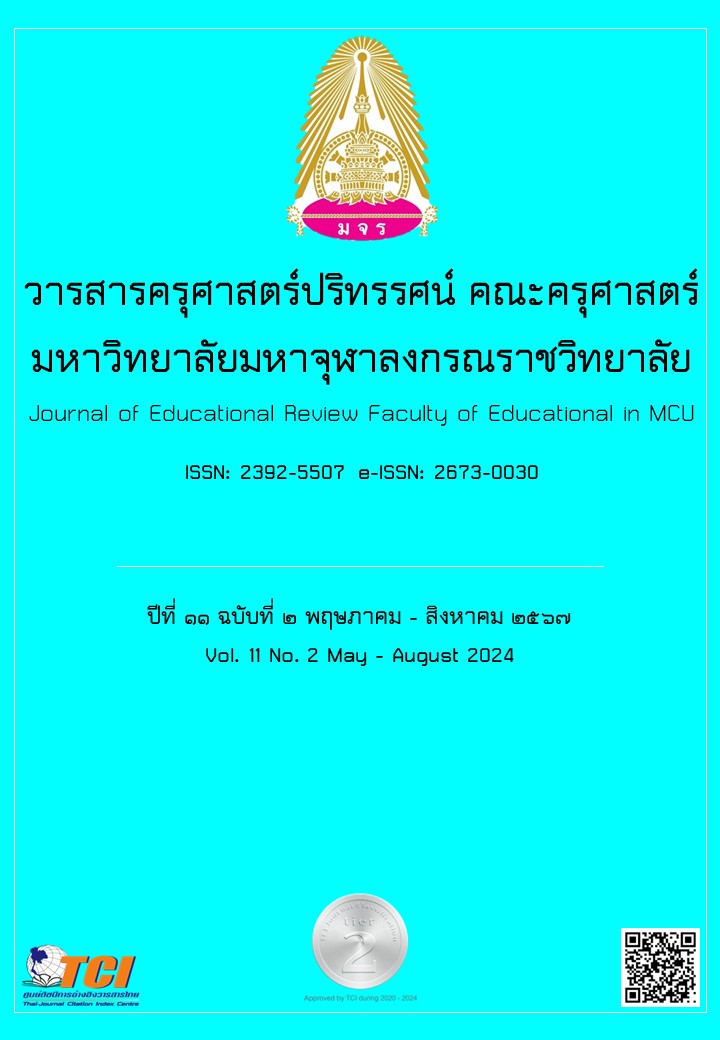การพัฒนาห้องเรียนจักรวาลนฤมิตร่วมกับแนวคิดการเรียนรู้ร่วมกัน เรื่อง การสร้างงาน อินโฟกราฟิก 3 มิติ ที่เสริมสร้างทักษะการคิดสร้างสรรค์ของนักเรียนชั้นมัธยมศึกษาปีที่ 4
Main Article Content
บทคัดย่อ
บทความวิจัยนี้เป็นการวิจัยเกี่ยวกับการพัฒนาห้องเรียนจักรวาลนฤมิตร่วมกับแนวคิดการเรียนรู้ร่วมกัน เรื่อง การสร้างงานอินโฟกราฟิก 3 มิติ ที่เสริมสร้างทักษะการคิดสร้างสรรค์ของนักเรียนชั้นมัธยมศึกษาปีที่ 4 การวิจัยครั้งนี้มีวัตถุประสงค์เพื่อ 1) เพื่อพัฒนาห้องเรียนจักรวาลนฤมิตร่วมกับแนวคิดการเรียนรู้ร่วมกัน ให้มีคุณภาพเหมาะสมและมีประสิทธิภาพตามเกณฑ์ 80/80 2) เพื่อเปรียบเทียบผลสัมฤทธิ์ทางการเรียนก่อนเรียนและหลังเรียนของนักเรียนที่จัดการเรียนการสอนในห้องเรียนจักรวาลนฤมิตร่วมกับแนวคิดการเรียนรู้ร่วมกัน 3) เพื่อเปรียบเทียบทักษะการคิดสร้างสรรค์ของนักเรียน ระหว่างกลุ่มที่เรียนในห้องเรียนจักรวาลนฤมิตร่วมกับแนวคิดการเรียนรู้ร่วมกันกับกลุ่มที่เรียนด้วยห้องเรียนแบบปกติ และ 4) เพื่อศึกษาความพึงพอใจของนักเรียน กลุ่มเป้าหมายที่ใช้ในการวิจัยครั้งนี้ คือ นักเรียนชั้นมัธยมศึกษาปีที่ 4 ภาคเรียนที่ 1 ปีการศึกษา 2566 จำนวน 40 คน โดยวิธีการสุ่มตัวอย่างแบบแบ่งกลุ่ม เป็นการวิจัยเชิงทดลอง มีเครื่องมือที่ใช้ในการวิจัย 1) ห้องเรียนจักรวาลนฤมิต 2) แบบทดสอบวัดผลสัมฤทธิ์ทางการเรียน 3) แบบประเมินทักษะการคิดสร้างสรรค์ 4) แบบประเมินความพึงพอใจ และสถิติที่ใช้ในการวิเคราะห์ข้อมูล ประกอบด้วยค่าเฉลี่ย ค่าเบี่ยงเบนมาตรฐาน ผลการวิจัยพบว่า 1) ห้องเรียนจักรวาลนฤมิตร่วมกับแนวคิดการเรียนรู้ร่วมกันมีประสิทธิภาพ 80.23 / 81.75 ซึ่งเป็นไปตามเกณฑ์ที่กำหนดไว้ 2) นักเรียนมีผลสัมฤทธิ์ทางการเรียนหลังจากเรียนด้วยการเรียนการสอนในห้องเรียนจักรวาลนฤมิตร่วมกับแนวคิดการเรียนรู้ร่วมกันมีผลสัมฤทธิ์ทางการเรียนเฉลี่ยหลังเรียนสูงกว่าก่อนเรียนกับกลุ่มที่เรียนในห้องเรียนปกติ อย่างมีนัยสำคัญทางสถิติที่ระดับ 0.05 3) นักเรียนมีความคิดสร้างสรรค์โดยกลุ่มที่เรียนในห้องเรียนจักรวาลนฤมิตร่วมกับแนวคิดการเรียนรู้ร่วมกันสูงกว่ากลุ่มที่เรียนด้วยห้องเรียนแบบปกติ อย่างมีนัยสำคัญทางสถิติที่ระดับ 0.05 และ 4) นักเรียนมีความพึงพอใจต่อการพัฒนาห้องเรียนจักรวาลนฤมิตร่วมกับแนวคิดการเรียนรู้ร่วมกัน อยู่ในระดับมาก
Article Details

อนุญาตภายใต้เงื่อนไข Creative Commons Attribution-NonCommercial-NoDerivatives 4.0 International License.
ทัศนะและความคิดเห็นที่ปรากฏในบทความในวารสารฉบับนี้ถือเป็นความรับผิดชอบของผู้เขียนบทความนั้นเพียงผู้เดียว และไม่ถือเป็นทัศนะและความรับผิดชอบของกองบรรณาธิการ
กองบรรณาธิการขอสงวนสิทธิ์ในการคัดเลือกบทความลงตีพิมพ์และจะแจ้งให้เจ้าของบทความทราบหลังจากผู้ประเมินบทความตรวจอ่านบทความแล้ว
ต้นฉบับที่ได้รับการตีพิมพ์ในวารสารครุศาสตร์ปริทรรศน์ คณะครุศาสตร์ มหาวิทยาลัยมหาจุฬาลงกรณราชวิทยาลัย ถือเป็นกรรมสิทธิ์ของคณะครุศาสตร์ มหาวิทยาลัยมหาจุฬาลงกรณราชวิทยาลัย ห้ามนำข้อความทั้งหมดหรือบางส่วนไปพิมพ์ซ้ำ เว้นเสียแต่ว่าจะได้รับอนุญาตจากมหาวิทยาลัยฯ เป็นลายลักษณ์อักษร
เอกสารอ้างอิง
กระทรวงศึกษาธิการ. (2564). แนวทางการจัดการเรียนการสอนในสถานการณ์การแพร่ระบาดของโรคติดเชื้อไวรัสโคโรนา 2019 (COVID-19) ภาคเรียนที่ 1 ปีการศึกษา 2564. กรุงเทพมหานคร: สำนักงานคณะกรรมการการศึกษาขั้นพื้นฐาน.
กระทรวงศึกษาธิการ. (2564). รายงานการศึกษาไทย พ.ศ. 2562-2564. กรุงเทพมหานคร: สำนักงานเลขาธิการสภาการศึกษากระทรวงศึกษาธิการ.
ณัฐนนท์ เกษตรเอี่ยม. (2565). การพัฒนาบทเรียนออนไลน์รูปแบบจักรวาลนฤมิตร่วมกับกระบวนการจัดการเรียนรู้เชิงรุก Active Learning รายวิชาออกแบบและเทคโนโลยี เรื่องเทคโนโลยีแก้ปัญหา ของนักเรียนระดับชั้นมัธยมศึกษาปีที่ 3. วิทยานิพนธ์การศึกษามหาบัณฑิต. มหาวิทยาลัยนเรศวร.
สำนักงานคณะกรรมการข้าราชการพลเรือน. (2560). หนังสืออิเล็กทรอนิกส์ การคิดเชิงสร้างสรรค์. แหล่งที่มา https://www.ocsc.go.th/sites/default/files/document/ocsc-2017-eb13.pdf สืบค้นเมื่อ 30 ส.ค. 2565.
สุรพล บุญลือ, สรัญญา เชื้อทอง, ไพฑูรย์ กานต์ธัญลักษณ์ และทิพรัตน์ สิทธิวงค์. (2558). การวิจัยและพัฒนาห้องเรียนเสมือนโดยใช้การเรียนรู้ร่วมกันและการเรียนการสอนแบบซินเนคติกส์ เพื่อพัฒนาความคิดสร้างสรรค์ของนักศึกษาระดับอุดมศึกษา ในสาขาครุศาสตร์ศึกษาศาสตร์และสาขาที่เกี่ยวข้อง. รายงานวิจัย. มหาวิทยาลัยเทคโนโลยีพระจอมเกล้าธนบุรี.
หัทยา ธัญญคุโณดม. (2561). การพัฒนากิจกรรมโครงงานคอมพิวเตอร์แบบผสมผสานร่วมกับแนวคิดกระบวนการกลุ่ม เพื่อส่งเสริมความสามารถในการเขียนโปรแกรมและการทำงานเป็นทีมของนักเรียนชั้นมัธยมศึกษาปีที่ 3. วิทยานิพนธ์ศึกษาศาสตรมหาบัณฑิต. มหาวิทยาลัยศิลปากร.
อัศณีย์ หมาดบำรุง และทศพร แสงสว่าง. (2559). การพัฒนาห้องเรียนเสมือนจริง เรื่อง การสร้างเว็บไซตด้วยโปรแกรมดรีมวีฟเวอร์ CS6 สำหรับนักเรียนชั้นประถมศกษาปีที่ 6. วารสารครุศาสตร์อุตสาหกรรม มหาวิทยาลัยเทคโนโลยีราชมงคลธัญบุรี. 4(1). 28-43.
Barbara Leigh Smith and Jean T. MacGregor. (1993). What is Collaborative Learning. the National Center on Postsecondary Teaching, Learning, and Assessment at Pennsylvania State University.
Law and Wong, (2003). ICT Imple Mentation and School Leadership: Case Studies of ICT Integration in Teaching and Learning. Journal of Educational Administration. 41. 158-170.
li Bronzetti, V. F. (2006). About VR. From http://www.fabricat.com/PDF_FILES/About%20VR.pdf Retrieved Aug 30, 2022.
Pesonet al. (2020). Offline or Online: How Should Biology Be Taught in a Flexible Learning Modality in the Philippines. Southeast Asian Journal of Science and Technology. 6(1). 30-38.
Torrance, P. (1974). Torrance Tests of Creative Thinking. New York: Personnel Press.
Virtually Anywhere. (2009). A virtual reality tour company that creates immersive VR media with attractive designs. From https://virtually-anywhere.com/ Retrieved Aug 30, 2022.
Zhu, Chang. (2012). Student satisfaction, performance, and knowledge construction in online collaborative learning. Journal of Educational Technology & Society. 15(1). 127-136.


